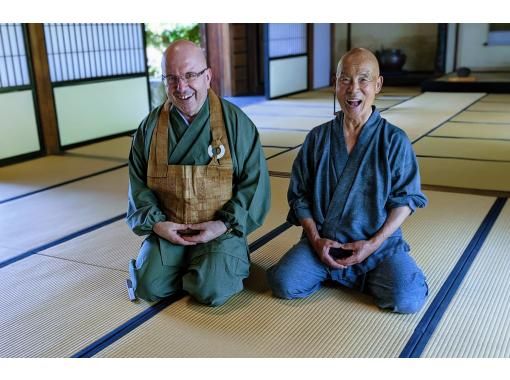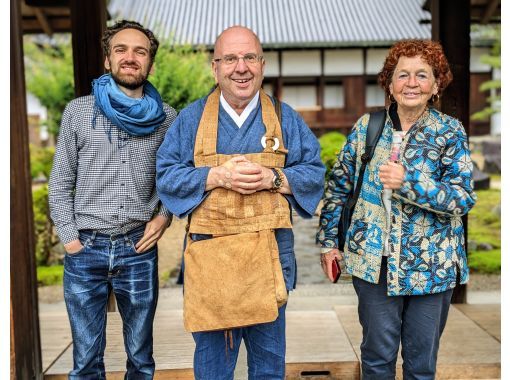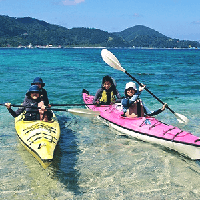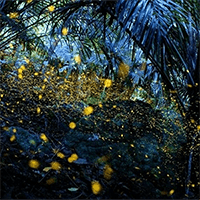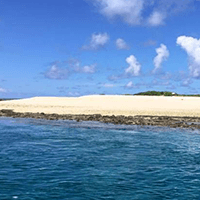Kansai in Sightseeing tour/Guided tour
- Age 6~Age 75
- Within 1 hour
- 10:00 / 11:00 / 12:00 / 13:00 / 14:00 / 15:00 / 16:00 / 17:00 / 18:00 / 19:00
Each kanji character has a meaning, and the appearance of the font is considered beautiful, so ``kanji'' themselves are very popular among foreigners, who often wear T-shirts with large kanji prints on them. Many of you may have seen foreigners with Chinese characters or kanji tattoos on their bodies. The customer chooses such a kanji, and we will explain the calligraphy mindset, tools, and movements, so that they can deeply understand ``Hinomoto Calligraphy'' and write down the kanji they have chosen with a brush.
海外からの友人カップルをつれて体験させていただきました。自分の名前と好きな漢字を習うことができてとても良い旅の経験になりました!次は別の体験も合わせて楽しんでもらおうと思います〜ありがとうございました!
- Age 6~Age 75
- Within 1 hour
- 10:00 / 11:00 / 12:00 / 13:00 / 14:00 / 15:00 / 16:00 / 17:00 / 18:00 / 19:00
The calligraphy of death is something that a samurai writes down with a brush as his last words in this world when he foresees his death. (Death refers to leaving this world) Customers can write their favorite kanji. You can select a character (kanji) and write it with an extra-large brush on SAMURAI paper (16 times the size of normal hanshi), which is made by combining two sheets of hanshi paper that is 8 times the size of normal hanshi paper. (Example) Yukimura Sanada's death note, ``If you go to live in an indefinite floating world, you will not know what will happen one day later.'' (In such an unstable world, we do not know what will happen tomorrow. Please think of Naniwa as something that doesn't exist in this world.'' Toyotomi Hideyoshi's deathbed writings, ``The dew falls, the dew falls and disappears.'' I wonder if Naniwa is also a dream within a dream (I became a citizen, but the dew fell and disappeared.) It was a life that seemed to disappear.)
外国のお友達をつれて一緒に参加させて頂きました。 珍しくて楽しい経験ができてとても喜んでおりました。 先生方もとてもポジティブにご指導して下さり本当に楽しかったです。 ありがとうございました。
- Age 14~Age 99
- 5~6 hours
- 10:00 / 10:30 / 11:00 / 11:30 / 12:00 / 12:30 / 13:00 / 13:30 / 14:00 / 14:30
Walk around Uji, the ancient capital of Kyoto, in a kimono. Feel free to wear a kimono and go out to tourist spots such as long-established tea shops, the Phoenix Hall of Byodo-in Temple, a World Heritage Site (World Cultural Heritage Site), and Ujikami Shrine. You are sure to find a kimono design that suits your taste. You can choose from a wide variety of new and beautiful kimonos and cute yukatas, all available for rental at a low price starting from 3,990 yen (tax included). For a limited time, we also offer a student discount plan. Our experienced dressing staff will consult with you on casual kimonos, yukatas, and popular antique kimonos. Find a kimono that suits you and enjoy a stroll around Uji with friends, parents and children, or as a couple.
- Age 6~Age 70
- 2~3 hours
- 11:00 / 14:00 / 17:00 / 20:00
Let's learn the bushido and experience the samurai spirit.What is the most important thing for a samurai? Wearing hakama, sandals, and a sword, and learning etiquette, manners, and kata. We call it the BUSHIDO sign.Next, as a BUSHIDO LEARN, you will experience the weight and sharpness of a real Japanese sword. We will learn the basics of swordsmanship (Battou and Nattou).We will take a break with SAMURAI TEA on the way. You will be entertained at a tea ceremony, as samurai risked their lives to "entertain" and "be entertained".Before participating in the final battle of the Warring States Period, the Battle of Osaka, the participants are asked to prepare for death and reflect on their own lives, writing their last words with a large brush on every piece of paper. This is called Deathbed calligraphy.At last, he puts on his armor and helmet to become a bushido master and goes to battle at the castle of Osaka to gain military merit in the battle of Osaka. However, when the defeat was imminent, the samurai, for the sake of honor, would not suffer the shame of the noose, even if they lost the battle, but would die by harakiri or cutting their belly before being captured.
- Age 6~Age 70
- 1~2 hours
- 11:00 / 14:00 / 17:00 / 20:00
Osaka no Jin ⚔ Pilgrimage to sacred places refers to the stages of battles such as the 1614 (Keicho 19) battle "Osaka Winter Jin" and the 1615 (Genna 1) restarted battle "Osaka Summer Jin" and other battles. It is to visit places connected to Osaka Castle as sacred places with “SAMURAI STYLE”. In addition, the term ``Japan's best soldier, who acted with great courage and speed'' in that battle was a name used to praise Sanada Nobushige (Yukimura), who was loyal to his lord, did not betray him even with money or territory, and was close to Tokugawa Ieyasu during the Summer Siege in Osaka. . Yukimura Sanada shined dazzlingly as a Sengoku military commander in the battle that concluded the Sengoku period. His vivid life still fascinates many people today, and let's make a pilgrimage to the sacred place of his glorious battle at Osaka, where he was praised as ``the greatest soldier in Japan.''
- Age 6~Age 70
- 1~2 hours
- 11:00 / 14:00 / 17:00 / 20:00
Osaka no Jin ⚔ Pilgrimage to sacred places refers to the stages of battles such as the 1614 (Keicho 19) battle "Osaka Winter Jin" and the 1615 (Genna 1) restarted battle "Osaka Summer Jin" and other battles. It is to visit places connected to Osaka Castle as sacred places with “SAMURAI STYLE”. In addition, the term ``Japan's best soldier, who acted with great courage and speed'' in that battle was a name used to praise Sanada Nobushige (Yukimura), who was loyal to his lord, did not betray him even with money or territory, and was close to Tokugawa Ieyasu during the Summer Siege in Osaka. . Yukimura Sanada shined dazzlingly as a Sengoku military commander in the battle that concluded the Sengoku period. His vivid life still fascinates many people today, and let's make a pilgrimage to the sacred place of his glorious battle at Osaka, where he was praised as ``the greatest soldier in Japan.''
- Age 6~Age 70
- 1~2 hours
- 11:00 / 14:00 / 17:00 / 20:00
This is a plan to commemorate and make a pilgrimage to the sad sacred place where SAMURAI and his friends were defeated in the Osaka Siege in the last war and fell to the castle, wearing armor and helmets reminiscent of the battle. ~ A famous castle that records the history of prosperity and turmoil of the people of Japan ~ This is how Osaka Castle is introduced on its official website. However, there was no trace of Osaka Castle, which boasted of being impregnable, as all of the moats other than the main castle and the moat that had been dug back during the peace of Ieyasu's plot at the Osaka Siege were filled in. The Tokugawa army destroyed the Sanada army and invaded the castle one after another, led by the Echizen army led by Matsudaira Tadanao, who was the first to arrive.The fire set by a Tokugawa army informer in the main castle kitchen quickly destroyed the castle tower. Osaka Castle finally fell at midnight on the 7th. When Hinomoto's greatest soldier, Nobushige, was a hostage of the Toyotomi family, he was liked by Toyotomi Hideyoshi, so he was treated more like a vassal than a hostage. The reason Yukimura sided with Toyotomi, who was at an overwhelming disadvantage at the Battle of Osaka, was to protect his loyalty to Hideyoshi. ``This Yukimura was summoned to a place where he was simply trying to prolong his life, and he was given honor as a samurai. This kindness cannot be replaced by land or money. ''When Ieyasu tried to persuade him to defect, he said, ``I have no intention of defecting even if I receive half of Japan.'' ``If you forget your debts and indulge in self-interest, can you call yourself a human being?'' he left behind the words of Hinomoto's greatest soldier.
- Age 6~Age 70
- 1~2 hours
- 11:00 / 14:00 / 17:00 / 20:00
Let's learn the bushido and experience the samurai spirit.What is the most important thing for a samurai? Wearing hakama, sandals, and a sword, and learning etiquette, manners, and kata. We call it the BUSHIDO sign.Next, as a BUSHIDO LEARN, you will experience the weight and sharpness of a real Japanese sword. We will learn the basics of swordsmanship (Battou and Nattou).We will take a break with SAMURAI TEA on the way. You will be entertained at a tea ceremony, as samurai risked their lives to "entertain" and "be entertained".Before participating in the final battle of the Warring States Period, the Battle of Osaka, the participants are asked to prepare for death and reflect on their own lives, writing their last words with a large brush on every piece of paper. This is called Deathbed calligraphy.At last, he puts on his armor and helmet to become a bushido master and goes to battle at the castle of Osaka to gain military merit in the battle of Osaka. However, when the defeat was imminent, the samurai, for the sake of honor, would not suffer the shame of the noose, even if they lost the battle, but would die by harakiri or cutting their belly before being captured.
- Age 13~Age 65
- 5~6 hours
- 09:30
This tour is an adventure tour that combines the mysterious world of Shugendo with the thrill of cave exploration. There are many caves and waterfalls in the Yoshino region of Nara Prefecture, and it has long been considered a sacred place for people who practice asceticism in the mountains. You can experience the beauty of nature and the depth of history by visiting the waterfalls and caves where ancient ascetics practiced. In particular, by exploring inside a cave, you can experience the sensation of entering the womb of the earth with all five senses, touch the mysteries of nature, and refresh your mind and body while being surrounded by a ``silent and mysterious'' atmosphere. **What is Shugendo? **Shugendo is a unique religious culture that incorporates elements of Buddhism and Shintoism into traditional Japanese ascetic practices, and values a sense of unity with nature. Mountains are considered sacred places, and asceticism is carried out in nature. Ascetics are called ``Yamabushi'' and aim for spiritual growth through meditation, waterfall training (asceticism where you are hit by a waterfall), asceticism in caves, etc. Shugendo, born from gratitude for being alive amidst the blessings of nature, is based on the idea that one can be reborn once again through rigorous training in nature. Caves have also been used as training sites. 1. **Arrival at Yoiyoi Nishikawa Base and Briefing**: - After arriving at Yoiyoi Nishikawa Base, you will receive a briefing on the tour overview, safety, and the cultural significance of the places you will visit. 2. **Introduction to Dragonfly Falls Hike**: - Visit Dragonfly Falls, which was also a training site for Shugendo, located a one-minute drive from Yoiyoi Nishikawa Base. Here, you will experience the training of Shugendo and how to face nature, including waterfalls. 3. **Lunch Break**: Have lunch at the park below Dragonfly Falls 4. **Preparing for Expedition**: - Return to Yoiyoi Nishikawa Base and prepare your exploration gear. Once you are ready, you will drive in your guide's car for about 15 minutes to the parking lot near the cave. 5. **Start of cave exploration**: - After arriving at the parking lot, the cave exploration will begin. The exploration begins by searching for the entrance of the cave. Please discover the cave with your own hands. In order to enjoy the cave exploration empty-handed, your luggage will be left in the car and your guide will take care of your valuables other than your smartphone. 6. **Cave exploration**:7. **Response after cave exploration**: - Return to the same parking lot and change from your dirty equipment. 8. **Hot spring bath**: - After the cave exploration, you can enjoy a hot spring bath. We will provide face towels. Please spend some time relaxing and soothing your tired body in the hot spring. 9. **Pick-up and disbandment**:
- Age 7~Age 90
- 2~3 hours
At Mitsuishi Fudoson, a traditional esoteric Buddhist temple that worships the waterfall where Kobo Daishi trained at the age of 21, we will practice rituals at the goma and make our wishes come true. The prayer priest is Sato Myosen (representative of the Kishu Koyasan Yokofue Association), a nun who lives in Mt. Koya. After the Goma prayer, if the weather is good, you can visit the waterfall and achieve a unique purification. Although you can apply for the Goma prayer experience alone, we recommend visiting in a group.
- Age 6~
- 1~2 hours
- 10:30 / 12:30 / 14:30
Wazuka-cho, Kyoto Prefecture, is the main producing area of Uji tea, and it is also known as the "chagenkyo" because of the beauty of its tea plantations. In Wazuka Town, a guided tea plantation walk for about 1 hour. The scenery that you can see while walking is definitely on Instagram ☆ After having enjoyed the story about tea with such scenery, we will carefully brew the Uji tea produced in Wazuka, which is recommended at that time. You'll be amazed at the scent and taste. Please enjoy it with a Japanese-style confectionery shop made in Wazuka Town.
普段、なかなか見ることができない茶畑を間近で見る事ができて良かったです。 ガイドの方が丁寧に分かりやすく説明をしてくださり、質問にも一つ一つ丁寧に答えてくださり、とても勉強になりました。 最後のお茶もとてもおいしく、茶殻を食べる事が出来たのはとても良い経験でした! ありがとうございました!
- Age 3~Age 80
- 1~2 hours
- 13:00
You can enjoy a full-scale sumo show supervised by former sumo wrestler Konishiki, a sumo experience, and a kimono haori experience. If you upgrade with an option, you can also enjoy traditional Japanese sumo cuisine. ☆ Flow of the day ☆ The reception is at the entrance of the store. Please arrive 30 minutes before the show. * In the unlikely event that you arrive after the show has started, please enter the store and proceed to the front of the torii gate as the curtains will be closed. A staff member will come to pick you up. ◎ From the time you arrive until the start of the sumo show, you can use the haori kimono that are available in the store while eating and using each booth. You can also take photos on the sumo ring. ・ Konishiki Booth You can actually see and touch the Konishiki booth, which displays the crested hakama, geta, and zabuton that Konishiki, the first foreign wrestler to reach the rank of ozeki, used to wear during his active career. ・ Kimono Booth You can use the kimono dressing service for a fee, and you can also purchase kimonos and obi (from 2,000 yen).・Food & Drinks You can also order and enjoy Chanko Nabe (2 servings from 4,000 yen) supervised by a sumo stable, street food, Japanese food (from 800 yen), and drinks (500 yen) at your seat. *If you are planning to eat or try on a kimono, we recommend that you arrive 60 minutes before the show starts. ◎Full-scale sumo show with sumo experience supervised by former ozeki Konishiki (approx. 50 to 80 minutes *5 minute break) ①Demonstration of sumo basics, movements, and rules (approx. 20 minutes) You can watch a full-scale sumo show supervised by Konishiki, a former sumo wrestler. You can learn about the basic movements of sumo, rules, winning moves, and prohibited moves. There is a quiz competition related to sumo and sumo wrestlers along the way, and if you answer the quiz correctly, everyone will receive a prize (sweets) ★ ③Best of three (approx. 5 to 10 minutes) A serious three-match match by former sumo wrestlers. It is a serious showdown without improvisation, where it is unclear who will win or lose. Everyone will throw a celebratory beanbag to the winning wrestler instead of a cushion. ④ Photo shoot (approximately 5-10 minutes) You will step onto the ring and take a photo with the former wrestler. *The photo will be taken with your mobile phone. You can also create a memorial label drink on the spot using the photo of your memories of today (1,000 yen). ⑤ Sumo experience (approximately 10-20 minutes) Wear a sumo suit or mawashi and wrestle with a former wrestler. You can feel the amazing power of the wrestlers. After the experience, you will take a photo with the wrestler while still in the sumo suit or mawashi. *Only available to those who wish to use the service on the day. We are trying to accommodate as many customers as possible, but if the number of applicants reaches the capacity, a lottery may be held. We may refuse use at the discretion of the staff, such as those who are drunk. Thank you for your understanding. ⑥ Calming Form - Ending - (approximately 2 minutes)
- Age 16~Age 90
- 1~2 hours
If you have any worries, or if there is something you want to hear but can't tell anyone, please come to the Kishu Koyasan Yokobue Society. The oldest things remaining at Koyasan are the Buddhist scriptures that Kobo Daishi brought back from China. These prayers are based on these scriptures. We will listen to your worries, such as chronic physical and mental symptoms, improving human relationships, and looking at the bright side of things, and show you the path to improvement through appropriate prayers.
- Age 13~Age 90
- Over 6 hours on the day
- 10:00
We will guide you to Wakayama's historical sites, where the scenery remains unchanged from 400 years ago. Enjoy a special atmosphere in a place that has not been turned into a tourist spot. Enjoy Japanese food culture with vegan cuisine for lunch and matcha green tea and Japanese sweets at tea time.
- Age 12~Age 90
- 1~2 hours /3~4 hours
Goshuin were originally used as proof of visiting temples and shrines. Recently, there is a "goshuin boom", and there are various elaborate goshuin. Artistry is also added to the red stamp. Therefore, you will make your own red stamp colored paper to commemorate your visit to Mt. Koya.
- Age 0~Age 110
- 4~5 hours
- 09:00 / 09:30
The activity is a place of encounter. Enjoy a day with Monk Pierre, combining discovery, lecture and meditation, in a day of Zen culture that has shaped Japan. This is a rare opportunity to visit one of the most beautiful temples in Japan, Kosho-ji in Uji, with a private visit from an expert. Pierre is a permanent guest of Kosho-ji. Zen is an invitation. You are therefore Pierre's guest, but also Kosho-ji's. Monk Pierre, who has been a monk for 40 years, will guide you through the corridors and gardens that he knows so well, and will share with you the secrets of the tradition that continues through the generations. He will tell you the story of the temple and its founder, Zen Master Dogen, convey the subtle meaning of the architecture, and help you decipher its rich meaning. In front of the garden, you can get a glimpse of the meaning of the landscape and, above all, explore your own curiosity about nature through a contemplation of stones, trees, water and space. In the garden, which is worthy of meditation and wonder, you can also experience haiku and Zen koans. Or you can simply savour tea. At the oldest Buddhist temple in Japan, we invite you to a meditation session where you can honestly face yourself, which is usually only available to monks. Let's try the direct experience of Shikantaza on the platform. ~Experience flow~ 9:00 Start 10:00 Temple guide 10:40 Zazen experience 12:00 Meal (lunch box) 13:00 One of the favorite workshops: Haiku and Koan workshop, magic, and finally calligraphy... Disband (Pick up at the station)
- Age 0~Age 110
- Over 6 hours on the day
- 09:00 / 09:30
This activity is a place of encounter. Enjoy a day with Monk Pierre, combining discovery, lecture and meditation, in a day of Zen culture that has shaped Japan. This is a rare opportunity to visit one of the most beautiful temples in Japan, Kosho-ji in Uji, with a private visit from an expert. Pierre is a permanent guest of Kosho-ji. Zen is an invitation. You are therefore Pierre's guest, but also Kosho-ji's. Monk Pierre, who has been a monk for 40 years, will guide you through the corridors and gardens that he knows so well, and will share with you the secrets of the tradition that continues through the ages. He will tell you the story of the temple and its founder, Zen Master Dogen, convey the subtle meaning of the architecture, and help you to decipher its rich meaning. In front of the garden, you can get a glimpse of the meaning of the landscape and, above all, explore your own curiosity about nature through a contemplation of stones, trees, water and space. In the garden, which is worthy of meditation and wonder, you can also experience haiku and Zen koans. Or you can simply savour a cup of tea. At Japan's oldest Buddhist temple, we invite you to a meditation session where you can honestly face yourself, which is usually only available to monks. Let's try the direct experience of Shikantaza on the platform. ~Experience flow~ 9:00 Start, temple guide 10:30 Zazen experience 10:40 Garden viewing, Buddhist history workshop 12:00 Meal (lunch box) 13:00 Choose three favorite workshops from the workshops: haiku and koan workshop, magic, and finally calligraphy... 16:00 Disband (Pick up at the station)
最近チェックしたプラン
Please wait a moment
![[By Osaka Castle] Learning Zen of Japanese Beauty Calligraphy in kimonoの画像](https://img.activityjapan.com/10/52954/10000005295401_0NLp2Urf_3.jpeg?version=1735455605)
![[Osaka castle] Learning Bushido & Zen at Samurai Calligraphy in kimonoの画像](https://img.activityjapan.com/10/52953/10000005295301_0NLp2Urf_3.jpg?version=1735455906)
![[Kyoto, Uji] Kimono and yukata complete rental plan Popular lace kimono and pure silk kimono available♪ Near long-established Uji matcha sweets shop and Tale of Genji Museumの画像](https://img.activityjapan.com/10/55308/10000005530801_eomBAEMI_3.jpeg?version=1723361466)
![[OsakaCastle] Hands-on class to learn Bushido/Harakiri & Zen with photoの画像](https://img.activityjapan.com/10/52660/10000005266001_lpXgdgDW_3.jpg?version=1735456203)
![[Osaka/Tamatsukuri] Osaka no Jin "Hinomoto's No. 1 Soldier" pilgrimage tour guide (Tamatsukuri area)の画像](https://img.activityjapan.com/10/52625/10000005262501_xEnFGyJR_3.jpg?version=1706264164)
![[Osaka/Tennoji] Osaka no Jin "Hinomoto's No. 1 Soldier" pilgrimage tour guide (Tennoji area)の画像](https://img.activityjapan.com/10/52569/10000005256901_xEnFGyJR_3.jpg?version=1706258885)
![[Osaka/Osaka Castle] Pilgrimage tour guide to the sacred sites of famous castles that mark the history of prosperity and turmoil among the people of Japan (Osaka Castle area)の画像](https://img.activityjapan.com/10/52567/10000005256701_xEnFGyJR_3.jpg?version=1735524365)
![[By Osaka Castle] Hands-on class to learn Bushido & Zen with photoの画像](https://img.activityjapan.com/10/52543/10000005254301_yvTwbz4o_3.jpg?version=1735524126)
![[Nara, Yoshino] Cave Adventures: Discover the Mystical Paths of Shugenの画像](https://img.activityjapan.com/10/56866/10000005686601_8OUZBun9_3.JPG?version=1733231762)
![[Wakayama/Hashimoto] Goma prayer experience to fulfill your wishes by a Shingon practitionerの画像](https://img.activityjapan.com/10/50507/10000005050701_QTRiVNk2_3.jpg?version=1693699145)
![[Kyoto Wazuka] Enjoy tea with all five senses! Walk in a tea field with a guide and relax in Wazuka tea in Uji Tea Town! With tea ballsの画像](https://img.activityjapan.com/10/32841/10000003284101_YFCRn0KY_3.jpg?version=1595311729)
![[Izumisano City] ◎Sumo show + sumo & kimono experience ◎"A sumo culture experience that can only be experienced here★" ◎Elementary school students and younger can watch the show and experience sumo for free◎の画像](https://img.activityjapan.com/10/54127/10000005412701_hutKXWpl_3.jpg?version=1732506304)
![[Wakayama, Mount Koya] Experience "Kaji and Prayer" based on the Shingon Esoteric Buddhism ritualの画像](https://img.activityjapan.com/10/50450/10000005045001_QTRiVNk2_3.jpg?version=1733192402)
![[Wakayama・Wakayama City] A tour to experience the scenery of the Edo period that still remains today along with the diary of painter Kawai Koume, who lived in the castle town! Recommended for women and couples!の画像](https://img.activityjapan.com/10/56478/10000005647801_AVWlGGNt_3.jpeg?version=1728023884)
![[Wakayama / Koyasan] Making good luck colored paper using red stampsの画像](https://img.activityjapan.com/10/43540/10000004354001_mF6wAgG0_3.jpg?version=1659583864)
